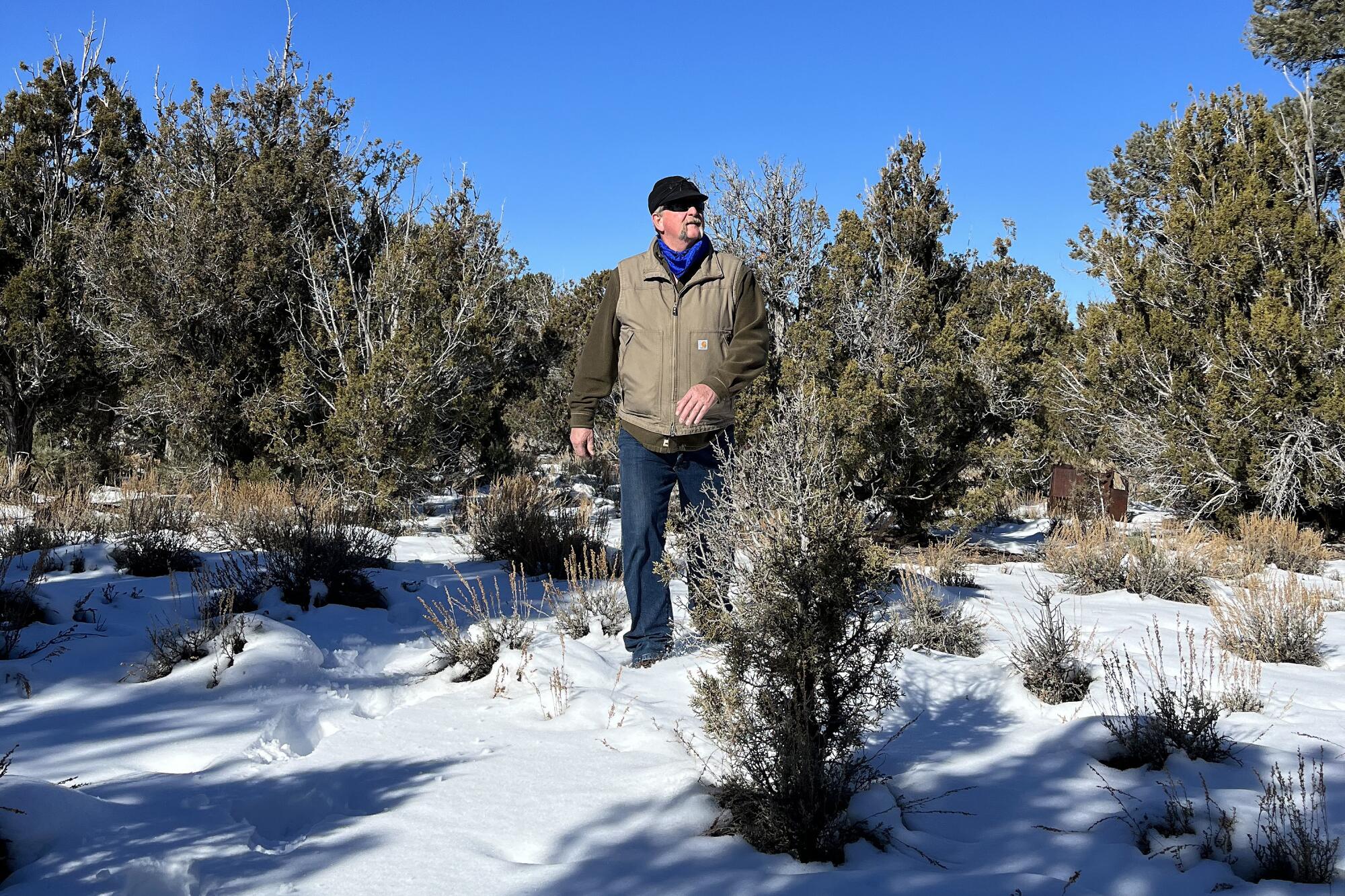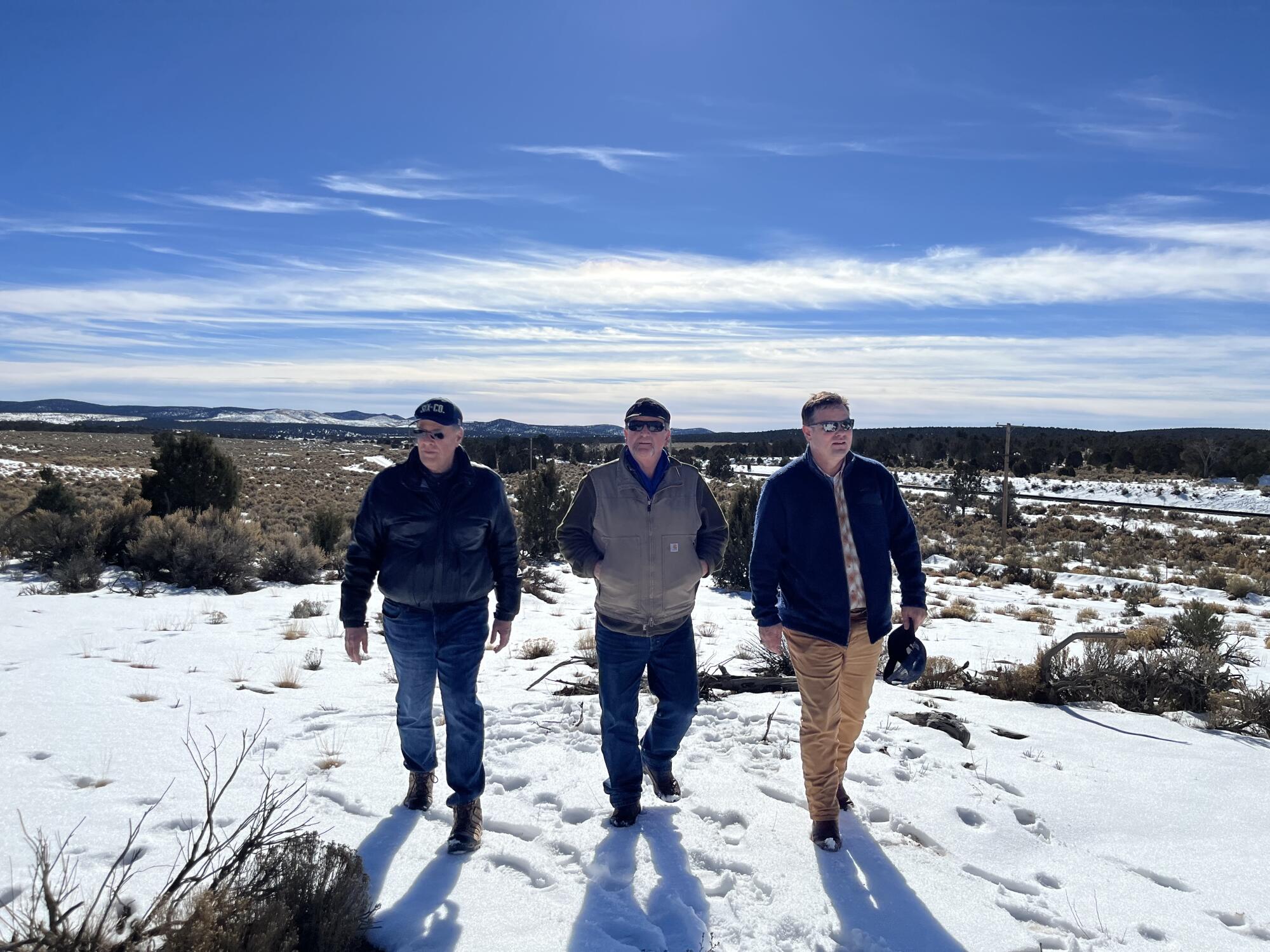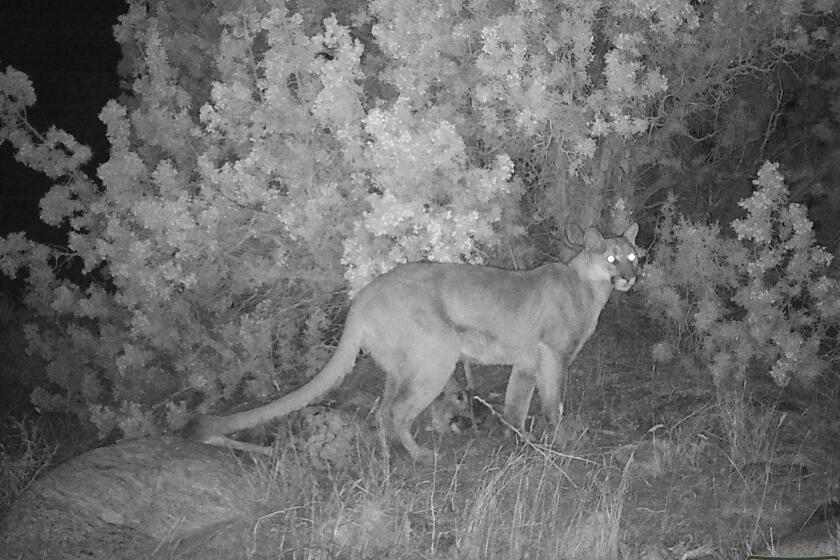
- Share via
CALIENTE, Nev. — When Varlin Higbee eyes the scrubby forest of pinyon pines and juniper trees that fill the high desert outside this old Union Pacific Railroad town, there’s just one thought that crosses his mind:
“They’re just a wildfire waiting to happen,” the Lincoln County commissioner says of the low, bushy trees.
And Higbee is not alone in his distaste for the plants.

Despite the many uses Native Americans once had for pinyon-juniper woodlands — not the least of which was sustenance from pine nuts — ranchers and federal land managers throughout the American Southwest have now come to regard them as a highly flammable and invasive scourge.
In parts of California and much of the Great Basin, land owners have declared war on pinyon pines and juniper trees, clearing them from rangelands with chains, bulldozers, saws and herbicides. At the same time, the trees are drawing increasing interest as a source of renewable energy — such as in California’s Lassen County, where 150,000 tons of the trees are fed into the Honey Lake Power Plant each year to generate energy for customers including San Diego Gas & Electric.
Most recently, Higbee and other Nevada officials have proposed converting them into green methanol — a biofuel that could be used for everything from generating electricity to powering cargo ships calling on the ports of Los Angeles and Long Beach.
Why are so many California EV charging stations broken? Lax state oversight of state subsidies is one big reason.
In January, Nevada Gov. Joe Lombardo signed a declaration of understanding with Denmark to develop an industrial park in Lincoln County where methanol would be extracted from wood and used as a fuel additive to reduce greenhouse gas emissions from diesel engines.
To hear Lombardo tell it, it’s a match made in heaven.
“This innovative and collaborative technology project produces clean renewable energy, while simultaneously utilizing trees that need to be thinned out to maintain a healthy forest,” Lombardo said.
Environmental groups, however, have blasted the plan. Among other criticisms, they say the deal with Denmark sets the stage for a fight over the future of an ecologically rich landscape, much of which has remained untouched by the glitz and bustle of Las Vegas and Reno.
Gary Hughes of Biofuelwatch, an advocacy group focused on the impact of bioenergy development, dismissed the proposal as “a technological dead end road and heartbreaking waste of healthy trees.”

Denmark — which is home to Maersk, the world’s largest container shipping company — has pledged to become 100% fossil fuel free by 2050, and bioenergy is a key part of that ambitious effort.
“Denmark is at the forefront of renewable energy developments and closer collaboration between Nevada and Denmark can only strengthen our joint quests to create economic growth and well-paid jobs — while also doing good for the environment and our planet,” read a statement from Danish Ambassador to the U.S. Jesper Møller Sørensen.
Nevada officials want to locate the facility in the middle of about 1.3 million acres of pinyon-juniper woodlands in public lands some 150 miles northeast of Las Vegas. The proposed site is also crossed by a Union Pacific mainline that terminates at the ports of Los Angeles and Long Beach.
The facility, according to officials, could attract $260 million in investments, create 150 sorely needed local jobs and become a model for creating similar industrial parks in other parts of Nevada.
Nanoplastics are microscopic flecks so small that they can be absorbed into human cells and tissue, as well as cross the blood-brain barrier.
But there are significant environmental issues involved in scalping eastern Nevada’s mountainous public lands of century-old trees standing 15 to 20 feet tall.
“I’d be surprised if this proposal is successful,” Hughes said. “So far, efforts to produce methanol from wood at scale for the aviation industry, for example, have all failed.”
Patrick Donnelly, Great Basin director for the Center for Biological Diversity, called it a new chapter in “our nation’s 200-year-long war on pinyon-juniper ecosystems.”
“Each generation finds a new excuse to justify their destruction because they don’t provide the economic benefits obtained from tall pine trees favored by the timber industry,” he said.
“Now, it seems the state of Nevada is popping champagne corks because it believes it has found a way of making money from the trees,” Donnelly said. “But I see it as a short-term carbon benefit at the expense of the long-term carbon sequestration benefits provided by a healthy forest.”
The development of renewable energy facilities — solar, wind, geothermal and biomass — on public lands has been a top priority of the federal government as it seeks to ease the nation’s dependence on fossil fuels and curb global warming.
With that goal in mind, the Bureau of Land Management is working closely in Lincoln County with the governor’s economic development office, engineers in Denmark, and Sixco Nevada Inc. — a consortium of companies focused on deployment of new technologies — to develop the proposal.
After two mountain lions who were transplanted to the Mojave Desert died of starvation, California wildlife officials have revised their relocation policy.
In the eyes of the BLM, pinyon pine and juniper trees are weedy species that invade sagebrush rangelands and increase the risk of wildfire. They say an overabundance of pinyon-juniper woodlands fueled the 2022 Calf Canyon-Hermits Peak fire in New Mexico, which burned 341,735 acres, a state record.
But environmentalists argue that the loss of the trees outweighs the benefits of biofuel and biomass production.
Pinyon-juniper woodlands absorb atmospheric carbon through the process of photosynthesis, and have been widespread for thousands of years in much of Nevada and Utah, as well as portions of California, Idaho, Oregon, Wyoming and Baja California. Critics of the biofuel project say the woodlands’ role in carbon storage is critical to battling climate change.
Environmentalists also worry that the loss and degradation of pinyon-juniper woodlands will pose a significant threat to a number of animal species, including the bright blue pinyon jay, which is under consideration for listing as a federally endangered species.

The Western Watershed Project and Center for Biological Diversity have filed a lawsuit in U.S. District Court challenging the BLM’s approval of a plan to remove pinyon-juniper forests across more than 380,000 acres of sagebrush shrublands on federal land in eastern Nevada.
The lawsuit claims the plan would eradicate habitat for imperiled sage grouse and pinyon jays with techniques including “chaining” — the dragging of an anchor chain from a U.S. Navy vessel between two bulldozers in order to uproot and crush pinyon-juniper forests and sagebrush.
Derick Hembd, president of Sixco Nevada, said the governor’s proposal calls for using shears and saws to harvest individual trees, leaving saplings and sagebrush untouched.
It remains to be seen, however, whether concerns over the future of pinyon jays and other creatures threaten to stall or derail the project in rural Lincoln County, which is best known as a gateway to the secretive Area 51 U.S. Air Force military installation.
But Higbee, 63, has high hopes for the proposal that could also breathe new life into struggling rural communities such as Caliente, where the population of about 1,100 people hasn’t budged in decades.
“We need to grow,” Higbee said with frustration. “I’m going to do everything in my power to get this project up and running.”
Toward a more sustainable California
Get Boiling Point, our newsletter exploring climate change, energy and the environment, and become part of the conversation — and the solution.
You may occasionally receive promotional content from the Los Angeles Times.










